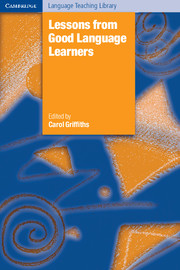Book contents
- Frontmatter
- Contents
- List of contributors
- Acknowledgements
- Editor's overview
- Prologue
- Reflections
- Part I Learner variables
- Part II Learning variables
- 12 Vocabulary and good language learners
- 13 Grammar and good language learners
- 14 Functions and good language learners
- 15 Pronunciation and good language learners
- 16 Listening and good language learners
- 17 Speaking and good language learners
- 18 Reading and good language learners
- 19 Writing and good language learners
- 20 Teaching/learning method and good language learners
- 21 Strategy instruction and good language learners
- 22 Errors correction and good language learners
- 23 Tasks and good language learners
- The learners' landscape and journey: a summary
- Index
14 - Functions and good language learners
Published online by Cambridge University Press: 11 August 2009
- Frontmatter
- Contents
- List of contributors
- Acknowledgements
- Editor's overview
- Prologue
- Reflections
- Part I Learner variables
- Part II Learning variables
- 12 Vocabulary and good language learners
- 13 Grammar and good language learners
- 14 Functions and good language learners
- 15 Pronunciation and good language learners
- 16 Listening and good language learners
- 17 Speaking and good language learners
- 18 Reading and good language learners
- 19 Writing and good language learners
- 20 Teaching/learning method and good language learners
- 21 Strategy instruction and good language learners
- 22 Errors correction and good language learners
- 23 Tasks and good language learners
- The learners' landscape and journey: a summary
- Index
Summary
Following disenchantment with grammar-based and situation-based methods, a functional approach to the teaching and learning of language was embraced in order to highlight the importance of learner-centered goals, a learner-centered view of language learning, and the analysis of learner needs for using language to communicate and interact with others. As the functional approach flourished, the concept of “function” gained multiple interpretations, such as the purpose of an utterance, the use to which a particular grammatical form is put, and the communicative purpose of a piece of language (Berns, 1984; Finocchiaro and Brumfit, 1983; Guntermann and Phillips, 1982; van Lier, 2001; Woodward, 2001). Our main questions from the point of view of the current volume are: how do good language learners develop functional competence (or the ability to use the language they are learning in real communication) and how can teachers facilitate the process?
Theoretical background
Over the years there have been a number of approaches to the teaching of language functions among which the Prague and the British traditions are perhaps the best known. Following Saussure (1916), the Prague school of linguistics viewed language as a system of units (for instance, sentence, word, morpheme, or phoneme), each serving some purpose or function and functionally related to other units (Berns, 1990; Crystal, 1991). The functional perspective on language set up by the Prague school is shown in its view of language as consisting of devices fulfilling certain functions and being understood only when the functional relation of each device to others is analyzed (Menšíková, 1972).
- Type
- Chapter
- Information
- Lessons from Good Language Learners , pp. 185 - 196Publisher: Cambridge University PressPrint publication year: 2008

